Fly-hunter Sand Wasp Bembix sp.
Family: Crabronidae. Subfamily: Bembicinae. Tribe: Bembicini
Kruger National Park, around Letaba © nan
Bembix, with 346 species recognised, is by far the most species rich genus of the Bembicinae. It is most diverse in the Afrotropical and Australian Regions, however, only about 43 species have been recorded from southern Africa.
All species of Bembix for which nesting has been described excavate multicellular sloping burrows in friable soil. Bembix typically prey on flies (Diptera) of various families.
AW Insect Book: Sawflies, Wasps, Bees & Ants (Hymenoptera)
Moderator: Klipspringer
-
Klipspringer
- Global Moderator
- Posts: 5862
- Joined: Sat Sep 14, 2013 12:34 pm
- Country: Germany
- Contact:
-
Klipspringer
- Global Moderator
- Posts: 5862
- Joined: Sat Sep 14, 2013 12:34 pm
- Country: Germany
- Contact:
Re: AW Insect Book: Sawflies, Wasps, Bees & Ants (Hymenoptera)
Shiny Sugar Ant Camponotus cinctellus
Superfamily Vespoidea. Family Formicidae. Subfamily Formicinae. Tribe Camponotini
Minor worker feeding on nectar, garden in Nelspruit © Richprins
Major worker foraging, Marloth park © Richprins
Another species first collected by Wilhelm Peters in Mozambique and decribed by Carl Eduard Adolph Gerstaecker as "Formica cinctella". No modern scientific description available.
Description
Workers (majors, mediae and minors) range from 5 to 10 mm. Thoracic profile smoothly convex. Large eyes behind the midline of the head. No sting, but "acipodore" for squirting acid. Majors are dull to shiny black all over, while the gaster (or bulbous posterior section) slightly shimmering golden to grey or olive green-hued (usually no pilosity on the first segment) and sports some pale bristles. The legs may have reddish tibia. Mediae and minors more reddish brown with similar pilosity.
Small workers have a more slender head and thorax, while major workers have much enlarged heads.
They forage by day and are quick.
Two subspecies are recognized: C. c. cinctellus (type locality in Mozambique) and C. c. belliceps (type locality in the DRCongo).
Original Description:
Distribution
It is native to eastern parts of Africa from Eritrea to Kenya, Rwanda, DR Congo, Tanzania, Mozambique (type locality), Zimbabwe and South Africa.
Habitat
Woodland, savanna, grassland, Eastern coastal belt forest, urban areas (gardens and dwellings).
Biology
Camponotus sp. built nests in the ground, in rotten branches or twigs, or rarely into living wood and most species possess a highly generalistic diet.
Links:
https://www.biodiversitylibrary.org/ite ... 0/mode/1up
http://antsofthecape.blogspot.com/p/ant ... gue_8.html
https://en.wikipedia.org/wiki/Camponotu ... kerbad.jpg
https://en.wikipedia.org/wiki/Camponotus_cinctellus
http://3.bp.blogspot.com/-tm0SGKCNyVU/V ... %2Bkey.jpg
Superfamily Vespoidea. Family Formicidae. Subfamily Formicinae. Tribe Camponotini
Minor worker feeding on nectar, garden in Nelspruit © Richprins
Major worker foraging, Marloth park © Richprins
Another species first collected by Wilhelm Peters in Mozambique and decribed by Carl Eduard Adolph Gerstaecker as "Formica cinctella". No modern scientific description available.
Description
Workers (majors, mediae and minors) range from 5 to 10 mm. Thoracic profile smoothly convex. Large eyes behind the midline of the head. No sting, but "acipodore" for squirting acid. Majors are dull to shiny black all over, while the gaster (or bulbous posterior section) slightly shimmering golden to grey or olive green-hued (usually no pilosity on the first segment) and sports some pale bristles. The legs may have reddish tibia. Mediae and minors more reddish brown with similar pilosity.
Small workers have a more slender head and thorax, while major workers have much enlarged heads.
They forage by day and are quick.
Two subspecies are recognized: C. c. cinctellus (type locality in Mozambique) and C. c. belliceps (type locality in the DRCongo).
Original Description:
Distribution
It is native to eastern parts of Africa from Eritrea to Kenya, Rwanda, DR Congo, Tanzania, Mozambique (type locality), Zimbabwe and South Africa.
Habitat
Woodland, savanna, grassland, Eastern coastal belt forest, urban areas (gardens and dwellings).
Biology
Camponotus sp. built nests in the ground, in rotten branches or twigs, or rarely into living wood and most species possess a highly generalistic diet.
Links:
https://www.biodiversitylibrary.org/ite ... 0/mode/1up
http://antsofthecape.blogspot.com/p/ant ... gue_8.html
https://en.wikipedia.org/wiki/Camponotu ... kerbad.jpg
https://en.wikipedia.org/wiki/Camponotus_cinctellus
http://3.bp.blogspot.com/-tm0SGKCNyVU/V ... %2Bkey.jpg
-
Klipspringer
- Global Moderator
- Posts: 5862
- Joined: Sat Sep 14, 2013 12:34 pm
- Country: Germany
- Contact:
Re: AW Insect Book: Sawflies, Wasps, Bees & Ants (Hymenoptera)
Sand-loving Wasp Tachytes sp.
Superfamily Apoidea. Family Crabronidae. Subfamily Crabroninae. Tribe Larrini
Kruger National Park © BluTuna
Tachytes is a worldwide genus, found throughout the temperate and tropical areas. It is very similar in appearance to Tachysphex and consequently these two genera may easily be confused. Around 38 species have been recorded from southern Africa. The name of the genus derives from the Greek ταχύτης (tachytes), meaning 'swiftness' or 'speed'.
The genus Tachytes Panzer is one of fifteen genera in the cosmopolitan tribe Larrini (Hymenoptera: Crabronidae: Crabroninae) and comprises about 296 species. The members of the genus are medium to large size wasps easily recognized by very elongated ocellar scars, comma-like in shape. They have a sturdy build and are very hairy, having a bee-like appearance. The body is often covered in hair with gold or silver shine, and transverse bands are often found on the abdomen.
Biology
Solitary predatory wasps, provisioning nest constructed in ground or plant stems with paralyzed adult Orthoptera, Hemiptera or Lepidoptera caterpillars for consumption by the wasp larvae. Recorded prey are mostly grasshoppers.
It seems from accounts of the nesting of this genus elsewhere in the world that its nesting behaviour is similar to that of Tachysphex and that the use of pre-existing cavities as a starting point for nest excavation is not uncommon.
Links:
https://www.waspweb.org/Apoidea/Crabron ... /index.htm
https://www.sanbi.org/sites/default/fil ... ies-24.pdf
https://ia800202.us.archive.org/18/item ... -98969.pdf
Superfamily Apoidea. Family Crabronidae. Subfamily Crabroninae. Tribe Larrini
Kruger National Park © BluTuna
Tachytes is a worldwide genus, found throughout the temperate and tropical areas. It is very similar in appearance to Tachysphex and consequently these two genera may easily be confused. Around 38 species have been recorded from southern Africa. The name of the genus derives from the Greek ταχύτης (tachytes), meaning 'swiftness' or 'speed'.
The genus Tachytes Panzer is one of fifteen genera in the cosmopolitan tribe Larrini (Hymenoptera: Crabronidae: Crabroninae) and comprises about 296 species. The members of the genus are medium to large size wasps easily recognized by very elongated ocellar scars, comma-like in shape. They have a sturdy build and are very hairy, having a bee-like appearance. The body is often covered in hair with gold or silver shine, and transverse bands are often found on the abdomen.
Biology
Solitary predatory wasps, provisioning nest constructed in ground or plant stems with paralyzed adult Orthoptera, Hemiptera or Lepidoptera caterpillars for consumption by the wasp larvae. Recorded prey are mostly grasshoppers.
It seems from accounts of the nesting of this genus elsewhere in the world that its nesting behaviour is similar to that of Tachysphex and that the use of pre-existing cavities as a starting point for nest excavation is not uncommon.
Links:
https://www.waspweb.org/Apoidea/Crabron ... /index.htm
https://www.sanbi.org/sites/default/fil ... ies-24.pdf
https://ia800202.us.archive.org/18/item ... -98969.pdf
Re: AW Insect Book: Sawflies, Wasps, Bees & Ants (Hymenoptera)
Narrow-gutted House Ant Pheidole tenuinodis (Mayr, 1901)
Family: Formicidae Subfamily: Myrmicinae Tribe: Pheidolini
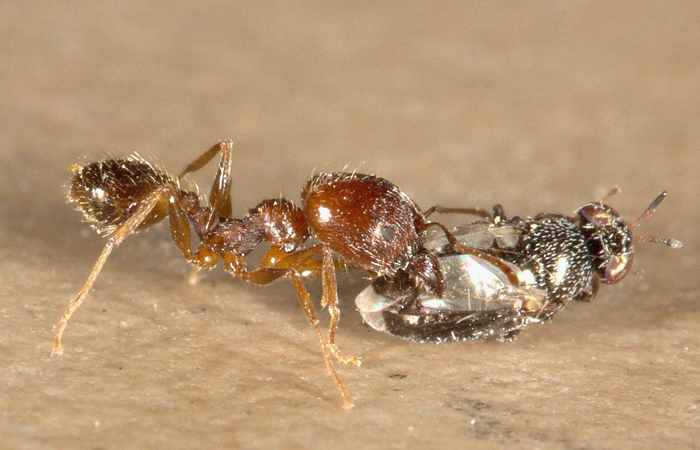
Major worker
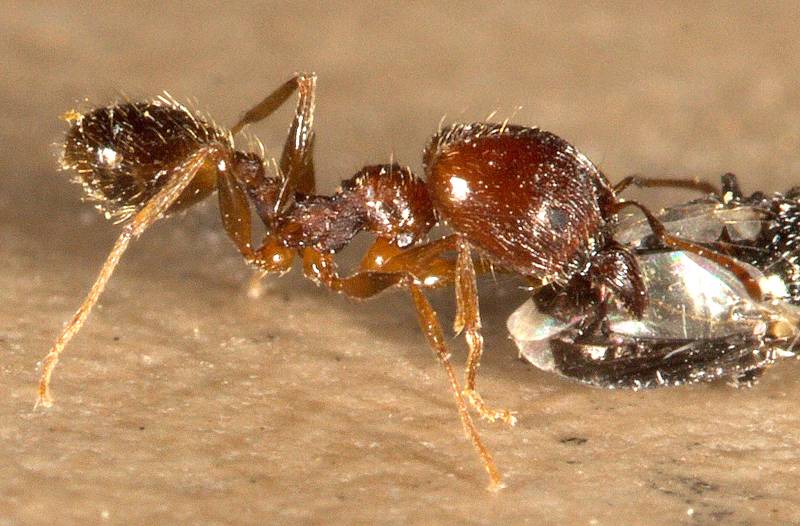
KTP by ExF
Genus Pheidole
Pheidole is a world-wide genus that probably includes over a thousand species. The genus is easily recognized by the presence of huge-headed major workers. These are often incorrectly characterised as ‘soldiers’, but they are in fact seldom involved in defence of the colony – they are much more likely to be the first to flee when danger threatens. Their huge heads and powerful jaws are apparently solely for use as ‘nutcrackers’, for cracking open seeds collected by the workers. It is not uncommon to find several heads of decapitated majors lying around outside the nest entrance, and it appears that in tough economic times the minor workers may get rid of the expensive, food-consuming majors.
The name Pheidole comes from the Greek pheidolos, meaning thrifty – presumably because they gather seeds to store against hard times.
There are 26 species with 32 subspecies in Southern Africa, but the genus as a whole is in urgent need of revision and it is in practice extremely difficult to be certain about many of the species without microscopic examination.
Pheidole tenuinodis Identification
*Majors: 4.5 mm. Head and alitrunk dark yellowish red, spines and propodeum dark brown with a paler brown gaster. Post-petiole about 75% wider than petiole and as long as wide. Front three-quarters of head strongly striate [grooved].
*Minors: 2.8 – 3.2 mm. Head and alitrunk dark brown to reddish brown, the rest yellowish brown; mostly smooth and shiny but with dull propodeum; pilosity long and abundant.

The Latin tenuinodis means ‘thin noded’.
There are four recognized sub-species: P. t. bothae, P. t. robusta, P. t. sipapomae, P. t. tenuinodis
Distribution
Southern Africa (Botswana, Namibia, South Africa, Zimbabwe)
South Africa (Western and Northern Cape, KZN, Mpumalanga, Free State, Limpopo, Gauteng)
East Africa (Malawi)
Diet
Pheidole spp. are omnivorous with some species exhibiting preferences for seeds and/or honeydew. Foragers collect food individually but sometimes employ group foraging along trunk trails leading to specific, localized food sources, such as a nectar secreting plant, or a plant heavily infested with honey-dew secreting Homoptera.
Biology
Nests are inconspicuous, typically with one, but occasionally up to five, entrances of 3 - 5 mm diameter. Members of this species are predominantly nocturnal to crepuscular.
https://www.antwiki.org/wiki/Pheidole_tenuinodis
http://antsofafrica.org/ant_species_201 ... inodis.htm
http://antsofafrica.org/ant_species_201 ... majors.htm
http://antbase.org/ants/publications/4430/4430.pdf
http://antsofthecape.blogspot.com/p/phe.html
Family: Formicidae Subfamily: Myrmicinae Tribe: Pheidolini

Major worker

KTP by ExF
Genus Pheidole
Pheidole is a world-wide genus that probably includes over a thousand species. The genus is easily recognized by the presence of huge-headed major workers. These are often incorrectly characterised as ‘soldiers’, but they are in fact seldom involved in defence of the colony – they are much more likely to be the first to flee when danger threatens. Their huge heads and powerful jaws are apparently solely for use as ‘nutcrackers’, for cracking open seeds collected by the workers. It is not uncommon to find several heads of decapitated majors lying around outside the nest entrance, and it appears that in tough economic times the minor workers may get rid of the expensive, food-consuming majors.
The name Pheidole comes from the Greek pheidolos, meaning thrifty – presumably because they gather seeds to store against hard times.
There are 26 species with 32 subspecies in Southern Africa, but the genus as a whole is in urgent need of revision and it is in practice extremely difficult to be certain about many of the species without microscopic examination.
Pheidole tenuinodis Identification
*Majors: 4.5 mm. Head and alitrunk dark yellowish red, spines and propodeum dark brown with a paler brown gaster. Post-petiole about 75% wider than petiole and as long as wide. Front three-quarters of head strongly striate [grooved].
*Minors: 2.8 – 3.2 mm. Head and alitrunk dark brown to reddish brown, the rest yellowish brown; mostly smooth and shiny but with dull propodeum; pilosity long and abundant.

The Latin tenuinodis means ‘thin noded’.
There are four recognized sub-species: P. t. bothae, P. t. robusta, P. t. sipapomae, P. t. tenuinodis
Distribution
Southern Africa (Botswana, Namibia, South Africa, Zimbabwe)
South Africa (Western and Northern Cape, KZN, Mpumalanga, Free State, Limpopo, Gauteng)
East Africa (Malawi)
Diet
Pheidole spp. are omnivorous with some species exhibiting preferences for seeds and/or honeydew. Foragers collect food individually but sometimes employ group foraging along trunk trails leading to specific, localized food sources, such as a nectar secreting plant, or a plant heavily infested with honey-dew secreting Homoptera.
Biology
Nests are inconspicuous, typically with one, but occasionally up to five, entrances of 3 - 5 mm diameter. Members of this species are predominantly nocturnal to crepuscular.
https://www.antwiki.org/wiki/Pheidole_tenuinodis
http://antsofafrica.org/ant_species_201 ... inodis.htm
http://antsofafrica.org/ant_species_201 ... majors.htm
http://antbase.org/ants/publications/4430/4430.pdf
http://antsofthecape.blogspot.com/p/phe.html
Re: AW Insect Book: Sawflies, Wasps, Bees & Ants (Hymenoptera)
Thick-noded House Ant Pheidole crassinoda (Emery, 1895)
Family: Formicidae. Subfamily: Myrmicinae. Tribe: Attini
The specific name is Latin meaning ‘thick swelling’, and refers to the wide post-petiole. There are three recognized subspecies: nominal plus pluto, ruspolii, sordidula.
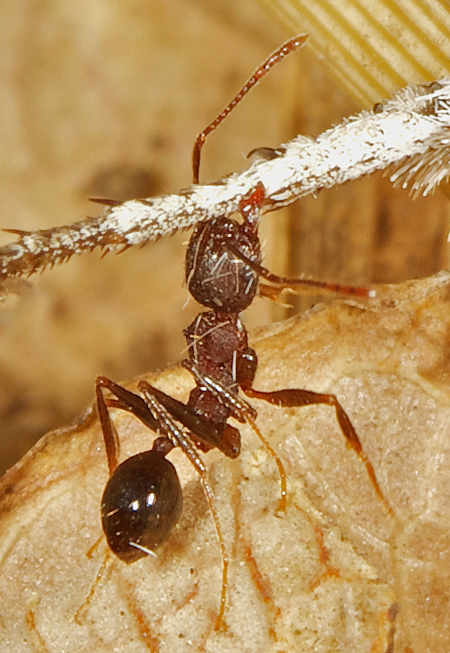
Minor
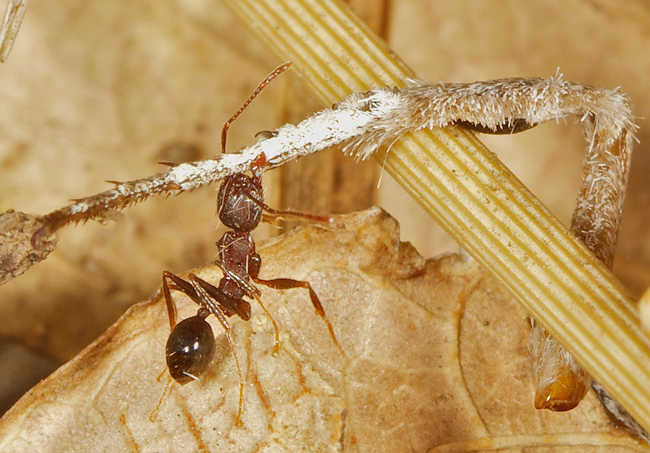
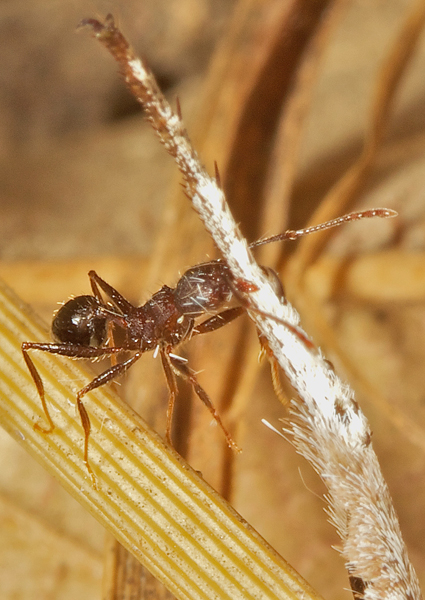
Kruger Nat’l Park by ExF
Identification
*Majors: 7.5 mm; pitch black with the front of the head and the base of the legs [coxae] dull to dark red. Head pitted and matt with fine striations [grooves]; petiole a simple elongate ellipse; post petiole about twice as wide as long.
*Minors: 4.0 – 4.4 mm; dark brown with appendages dark red; propodeal spines minute and triangular.

Distribution
Afrotropical Region: (South Africa, Botswana, Mozambique, Namibia, Swaziland, Zimbabwe, Uganda, Kenya)
South Africa (type locality): KwaZulu-Natal, Mpumalanga, Gauteng, North West
Habitat
Known from woodland habitats and sugar cane.
Co-operative Transport of Prey in P. crassinoda
The conclusions of the above study are summarized here:
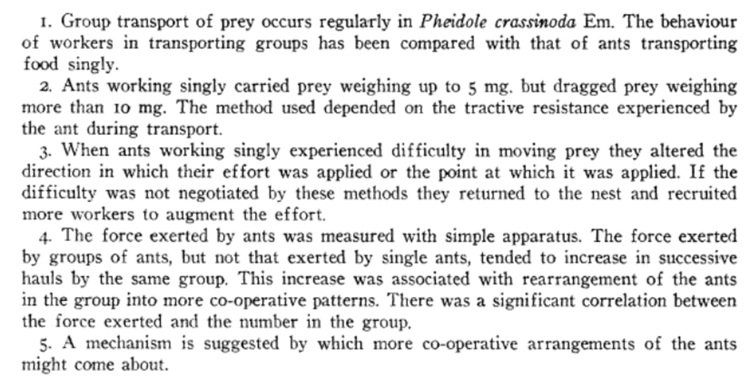
http://antsofthecape.blogspot.com/p/phe.html
https://www.antwiki.org/wiki/Pheidole_crassinoda
https://www.inaturalist.org/taxa/632219
https://www.jstor.org/stable/4532957?se
Family: Formicidae. Subfamily: Myrmicinae. Tribe: Attini
The specific name is Latin meaning ‘thick swelling’, and refers to the wide post-petiole. There are three recognized subspecies: nominal plus pluto, ruspolii, sordidula.

Minor


Kruger Nat’l Park by ExF
Identification
*Majors: 7.5 mm; pitch black with the front of the head and the base of the legs [coxae] dull to dark red. Head pitted and matt with fine striations [grooves]; petiole a simple elongate ellipse; post petiole about twice as wide as long.
*Minors: 4.0 – 4.4 mm; dark brown with appendages dark red; propodeal spines minute and triangular.

Distribution
Afrotropical Region: (South Africa, Botswana, Mozambique, Namibia, Swaziland, Zimbabwe, Uganda, Kenya)
South Africa (type locality): KwaZulu-Natal, Mpumalanga, Gauteng, North West
Habitat
Known from woodland habitats and sugar cane.
Co-operative Transport of Prey in P. crassinoda
The conclusions of the above study are summarized here:

http://antsofthecape.blogspot.com/p/phe.html
https://www.antwiki.org/wiki/Pheidole_crassinoda
https://www.inaturalist.org/taxa/632219
https://www.jstor.org/stable/4532957?se
Re: AW Insect Book: Sawflies, Wasps, Bees & Ants (Hymenoptera)
Hotrod Ant Ocymyrmex fortior (Santschi, 1911)
Family Formicidae. Subfamily Myrmicinae. Tribe Crematogastrini
Ants of this genus move very swiftly and erratically, faster than any other ants as noted by Arnold and other observers. Additionally, they are active in the hottest part of the day.
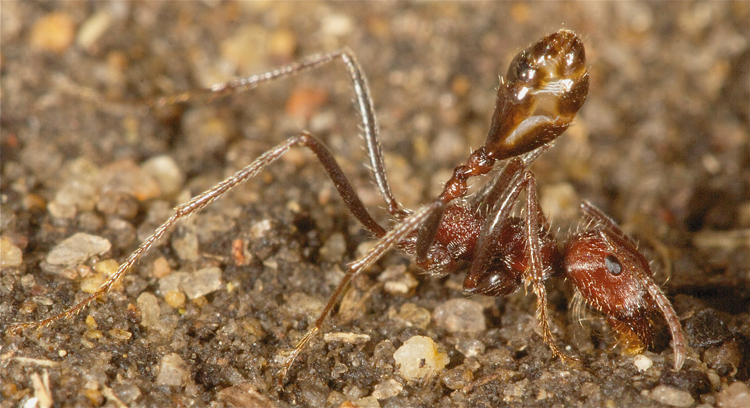
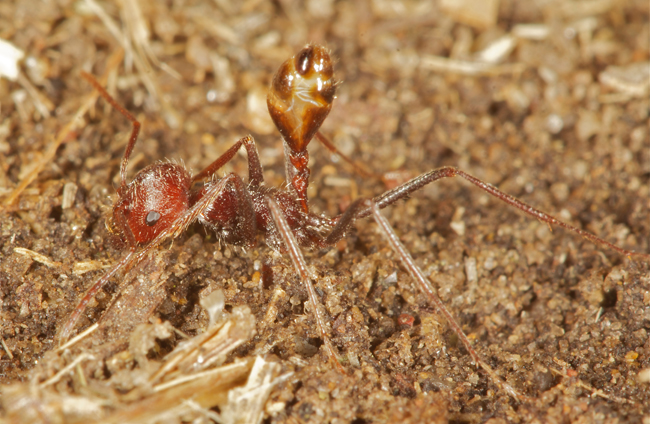
Kruger Natl Park by ExF
One of the most widespread species in southern Africa and in prevailingly grassy areas of the Kruger National Park, South Africa, this species is quite common.
Identification (a more complete description can be found in the link below*)
Ant Anatomical Terminology: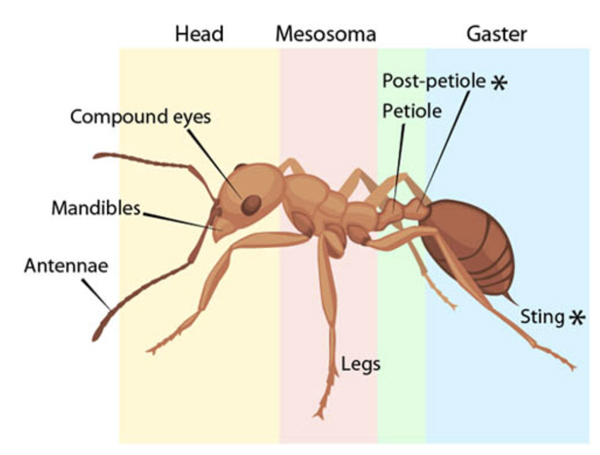
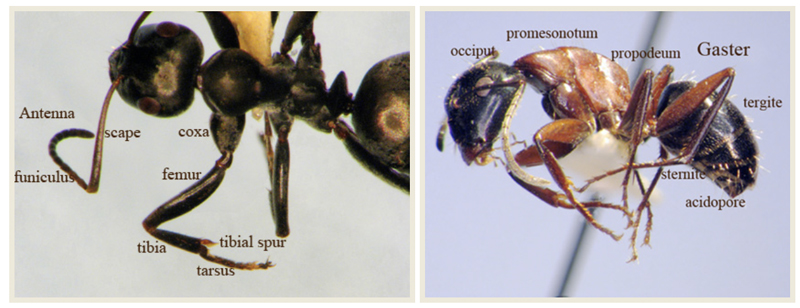
O. fortior worker description:
~Anterior clypeal margin with a semicircular median impression which is flanked on each side by a small tooth or denticle.
~ Promesonotal dorsum evenly shallowly convex in profile, the convex portion not strongly raised above the level of the propodeum so that the slope of the posterior half of the mesonotum is very shallow indeed. Propodeal dorsum flat or slightly sloping, rounding evenly into the declivity, the slope of which is quite steep but by no means vertical.
~Peduncle of petiole commonly without a ventral process but quite frequently a low rounded bulge is present. Petiole node small and low in profile, evenly rounded, the transition from dorsal surface of peduncle to anterior face of node involving a marked change of slope. Petiole node in dorsal view slender, small, varying from longer than broad to slightly broader than long.
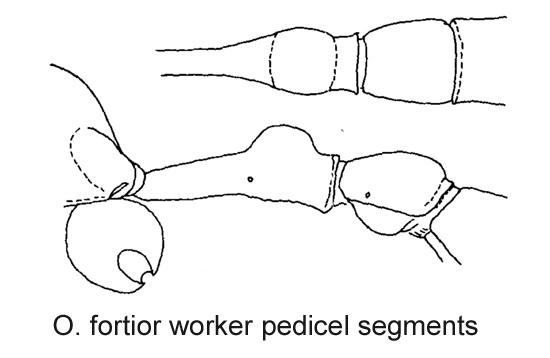
~Postpetiole in dorsal view longer than broad, sometimes only slightly so, but usually the difference easily visible. Postpetiole only with a superficial patterning or more or less smooth.
~Base of first gastral tergite strongly constricted and forming a narrow neck behind the postpetiole.
~Ground-sculpture of fine punctulation is present everywhere.
~All dorsal surfaces of head and alitrunk with hairs of varying length, the hairs of the first gastral tergite much shorter and sparser than on the alitrunk.
~Head and alitrunk varying from dull brick-red to lighter red, the two always the same colour; gaster darker, blackish brown to black.
Among the Ocymyrmex species with a strongly constricted base to the gaster and a developed clypeal impression, fortior is defined more by its lack of specialized characters than the possession of them.
Distribution
Afrotropical Region: Angola (type locality), Botswana, Namibia, South Africa, Zambia, Zimbabwe.
Biology
Workers of fortior close the nest entrance with small stones during periods of nest inactivity. Also, in Zimbabwe, fortior workers have been seen adding small stones to the crater-like nest entrance that were picked up from the around some distance away from the nest. This suggests that the crater is not just a by-product of the nest excavation but an important feature of the nest entrance. Its function is not fully understood, but its presence may facilitate the deliberate blocking of the entrance.
http://antsofafrica.org/ant_species_201
*https://www.antwiki.org/wiki/Ocymyrmex_fortior
https://www.antwiki.org/wiki/images/d/d ... h_1989.pdf
Family Formicidae. Subfamily Myrmicinae. Tribe Crematogastrini
Ants of this genus move very swiftly and erratically, faster than any other ants as noted by Arnold and other observers. Additionally, they are active in the hottest part of the day.


Kruger Natl Park by ExF
One of the most widespread species in southern Africa and in prevailingly grassy areas of the Kruger National Park, South Africa, this species is quite common.
Identification (a more complete description can be found in the link below*)
Ant Anatomical Terminology:


O. fortior worker description:
~Anterior clypeal margin with a semicircular median impression which is flanked on each side by a small tooth or denticle.
~ Promesonotal dorsum evenly shallowly convex in profile, the convex portion not strongly raised above the level of the propodeum so that the slope of the posterior half of the mesonotum is very shallow indeed. Propodeal dorsum flat or slightly sloping, rounding evenly into the declivity, the slope of which is quite steep but by no means vertical.
~Peduncle of petiole commonly without a ventral process but quite frequently a low rounded bulge is present. Petiole node small and low in profile, evenly rounded, the transition from dorsal surface of peduncle to anterior face of node involving a marked change of slope. Petiole node in dorsal view slender, small, varying from longer than broad to slightly broader than long.

~Postpetiole in dorsal view longer than broad, sometimes only slightly so, but usually the difference easily visible. Postpetiole only with a superficial patterning or more or less smooth.
~Base of first gastral tergite strongly constricted and forming a narrow neck behind the postpetiole.
~Ground-sculpture of fine punctulation is present everywhere.
~All dorsal surfaces of head and alitrunk with hairs of varying length, the hairs of the first gastral tergite much shorter and sparser than on the alitrunk.
~Head and alitrunk varying from dull brick-red to lighter red, the two always the same colour; gaster darker, blackish brown to black.
Among the Ocymyrmex species with a strongly constricted base to the gaster and a developed clypeal impression, fortior is defined more by its lack of specialized characters than the possession of them.
Distribution
Afrotropical Region: Angola (type locality), Botswana, Namibia, South Africa, Zambia, Zimbabwe.
Biology
Workers of fortior close the nest entrance with small stones during periods of nest inactivity. Also, in Zimbabwe, fortior workers have been seen adding small stones to the crater-like nest entrance that were picked up from the around some distance away from the nest. This suggests that the crater is not just a by-product of the nest excavation but an important feature of the nest entrance. Its function is not fully understood, but its presence may facilitate the deliberate blocking of the entrance.
http://antsofafrica.org/ant_species_201
*https://www.antwiki.org/wiki/Ocymyrmex_fortior
https://www.antwiki.org/wiki/images/d/d ... h_1989.pdf


